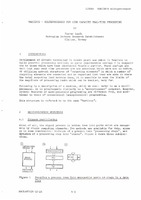| dc.contributor.author | Lundh, Yngvar | |
| dc.date.accessioned | 2018-10-11T14:05:01Z | |
| dc.date.available | 2018-10-11T14:05:01Z | |
| dc.date.issued | 1979/12 | |
| dc.identifier | 506 | |
| dc.identifier.govdoc | CP-25/1 | |
| dc.identifier.uri | http://hdl.handle.net/20.500.12489/42 | |
| dc.description.abstract | Development of circuit technology in recent years now makes it feasible to build powerful processing machines at quite considerable savings - in comparison to those which have been considered feasible earlier. These savings are such that many real time processes are now practical which were not so before. By utilizing network structures of "computing elements" in which a number of computing elements are connected and so organized that they are able to share the total computing load between them, it is possible to move the limits of the magnitude of processing tasks which can be handled, very far. Following is a description of a machine~ which we shall refer to as a multiprocessor. It is programmable similarly to a "monoprocessor" computer. However, several features of multiprocessor programming are different from, and additional to those of conventional (monoprocessor) programming. This structure is referred to by the name "Martinus". | |
| dc.format | 8 p. : ill. ; digital, PDF file | |
| dc.language | English | |
| dc.publisher | NATO. SACLANTCEN | |
| dc.source | In: Real-time, general purpose, high-speed signal processing systems for underwater research (SACLANTCEN Conference Proceedings CP-25), Part 1, 1979, pp. 9-1 - 9-8. | |
| dc.subject | Sonar | |
| dc.subject | Signal processing | |
| dc.subject | Computer systems | |
| dc.title | Martinus - multiprocessor for high capacity real-time processing | |
| dc.type | Papers and Articles | |
| dc.type | Conference Proceedings (CP) | |
